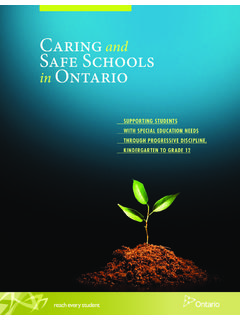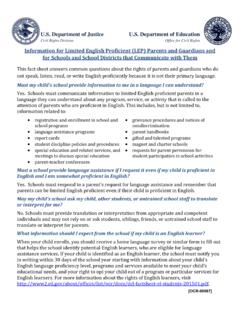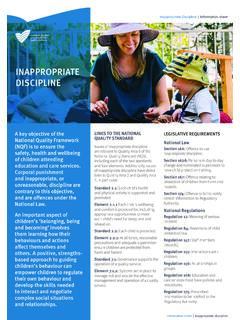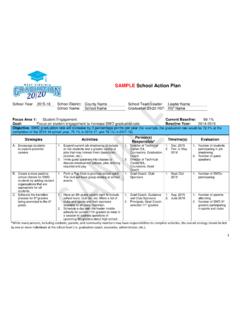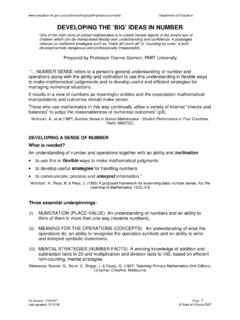Transcription of Impact of Discipline on Academic Performance of Pupils in ...
1 Journal of Education and Practice ISSN 2222-1735 (Paper) ISSN 2222-288X (Online) , , 2016 164 Impact of Discipline on Academic Performance of Pupils in Public primary Schools in Muhoroni Sub-County, Kenya Nicholas Odoyo Simba*, John Odwar Agak and Eric K. Kabuka Department of Educational Psychology, Maseno University, Box 333, Maseno, Kenya Abstract In Muhoroni Sub-County, Kenya, Pupils Academic Performance has received little attention in relation to Discipline . The objectives of this study were to determine the level of Discipline and extent of Impact of Discipline on Academic Performance among class eight Pupils in the sub-county s public primary schools. The study adopted descriptive survey and correlational research designs.
2 The study population comprised 2,450 class eight Pupils in the sub-county s public primary schools. From 34 randomly selected schools, 817 Pupils were selected by stratified random sampling. Questionnaires were used to collect data on Discipline and Academic Performance of the Pupils . Reliability coefficients of the questionnaires were determined by test-retest method and found to be and for questionnaire on Discipline and Academic Performance respectively. The questionnaires face and content validity was ascertained by experts. Results indicated that 46 ( ), 214 ( ), 413( ) and 144 ( ) of the Pupils had low, moderate, high, and very high Discipline respectively. Also, Discipline related positively with, and accounted for 23% of variance in the Pupils Academic Performance (R =.)
3 480, = .480, R2 = .230, p < .05). The study recommended enhancement of Discipline among the Pupils for improvement of their Academic Performance . Keywords: Academic Performance , Discipline , Impact , Pupils , primary Schools. 1. Introduction Backgrounds to the Study Researchers appreciate that Discipline is an important component of human behavior and assert that without it an organization cannot function well towards the achievement of its goals (Ouma, Simatwa, & Serem, 2013). In the context of a school system, a disciplined student is that student whose behaviours, actions and inactions conform to the predetermined rules and regulations of the school (Ali, Dada, Isiaka, & Salmon, 2014). However, Discipline ideally means more than adhering to rules and regulations and entails the learner s ability to discern what is right or wrong (Gitome, Katola, & Nyabwari, 2013).
4 Discipline is widely acknowledged to be essential for creating a positive school climate conducive to sound Academic Performance (Masitsa, 2008). It is a basic requirement for successful teaching and learning in schools and a subject of concern for teachers (Eshetu, 2014). According to Gitome et al., where there is good Discipline , there is improved Academic Performance . In other words, Discipline is vital for students Academic Performance (Njoroge & Nyabuto, 2014). Furthermore, it is necessary for effective school management and accomplishment of its goals (Nakpodi, 2010). Lack of Discipline is called indiscipline. Therefore, indiscipline can be seen as any action considered to be wrong and not generally accepted as proper in a set up or society (Omote, Thinguri, & Moenga, 2015). Among students, according to Ali et al.
5 , it is any form of misbehaviour which a student can display in several ways ( , disobedience, destruction of school property, poor attitude to learning, immoral behaviour, drug abuse, stealing, lateness, truancy, dirtiness, being quarrelsome, use of abusive or foul languages, rudeness, gangstarism or cultism). The literature reveals that student indiscipline is experienced in schools globally (Ali et al., 2014; Moyo, Khewu, & Bayaga, 2014; Omote et al., 2015; Rahimi & Karkami, 2015; Yahaya et al., 2009). A study in West Virginia in the United States of America (USA) revealed that about of 160,480 students (from grade 3 to 11) had one or more referrals for inappropriate behaviors (Whisman & Hammer, 2014). In Africa, researchers have pointed out the seriousness of indiscipline in schools in various countries. The countries include Ghana (Gyan, Baah-Korang, Mccarthy, & Mccarthy, 2015), South Africa (Marais & Meier, 2010; Masitsa, 2008), Botswana (Garegae , 2008), Nigeria (Okiemute ,2011; Nakpodia, 2010: Umezinwa & Elendu ,2012), and Tanzania (Yaghambe & Tshabangu ,2013).
6 Umezinwa and Elendu for instance, observed that indiscipline among learners in Nigeria was high and experienced at all levels including primary schools. In Kenya, lack of Discipline in schools has been one of the challenges facing schools (Njoroge & Nyabuto , 2014). The Kenya National Examinations Council (KNEC) revealed that between 90% and 100% of teachers in primary schools in Kenya encountered disciplinary problems among their Pupils (KNEC, 2010). In a study by Gakure, Mukuria, and Kithae (2013) in primary schools in Gatanga District, Kenya, 70% of selected 56 teachers indicated that their schools had cases of pupil indiscipline. Research shows that various Discipline problems exist among primary Journal of Education and Practice ISSN 2222-1735 (Paper) ISSN 2222-288X (Online) , , 2016 165 school Pupils in Kenya.
7 They include truancy , theft , sneaking, cheating, lateness, noise making, absenteeism, fighting, defiance, bullying, drug abuse, failure to complete assignments, sexual harassment, use of abusive language, drug trafficking and possession of pornography (Ouma et al., 2013). The vital role of Discipline in students Academic Performance is revealed or implied by a number of previous studies carried out in Kenya (Dawo & Simatwa, 2010; Gitome et al., 2013; Sureiman, 2010; Tikoko & Bomett, 2011) and in other African countries (Ehiane , 2014; Keating & Rossouw ,2009 ). This is supported and corroborated by a number of studies in European , Asian and American countries (Bodovski, Nahum-Shani, & Walsh, 2013; Duckworth & Seligman, 2006; Ning, Van-Dammme, Yang, & Gielen, 2013; Pasternak, 2013; Whisman & Hammer, 2014; Zhao & Kuo, 2015 ).
8 A few studies however suggest that Discipline has minimal, uncertain or non significant influence on students Academic Performance or achievement (Gakure et al., 2013; Zimmerman & Kitsantas, 2014). Therefore, findings on Impact of Discipline on students Academic Performance are inconsistent and somehow inconclusive .Furthermore, only a few of the stated previous studies ( , Duckworth & Seligman, 2006; Pasternak, 2013; Zhao & Kuo, 2015) were correlational in design. Nevertheless, in their measure of student Discipline , the few correlational studies focused on self- Discipline and excluded social skills such as obedience, politeness, and social competence ( , ability to get along with other people). In addition, in Muhoroni Sub-County, Kenya, Pupils Academic Performance has received little research attention in relation to Discipline .
9 The inconsistency of findings and the identified gaps suggested the need for more research on Pupils Academic Performance in relation to Discipline . To address the identified gaps, the current study focused on Muhoroni Sub-County and adopted a correlational design in examining the Impact of Discipline on Pupils Academic Performance . It also adopted a wider perspective of Discipline by considering Discipline generally as a personal attribute characterized by obedience, politeness, social competence ( , ability to get along with other people), orderliness, and Academic efficiency ( , competence in undertaking Academic tasks and obligations). Objectives of the Study i. To determine the level of Discipline of class eight Pupils in public primary schools in Muhoroni Sub-County, Kenya.
10 Ii. To determine the extent of Impact of Discipline on Academic Performance of class eight Pupils in public primary schools in Muhoroni Sub-County, Kenya. 2. Methodology Research Design Descriptive survey design and correlational design were used in the study. A descriptive survey attempts to describe or document current conditions or attitudes (Wimmer & Dominick, 2013) while correlational designs allow researchers to describe the relationship between two measured variables (Jackson, 2014). Area of the Study The study was carried out in Muhoroni Sub-County, Kenya. The sub-county lies approximately within longitudes 34o 52' E and 35o 19' E, and latitudes 0o and 26' S. According to Muhoroni Sub-County Education Office (2013), the sub-county has 130 primary schools (100 public and 30 private) with a total of 39, 391 Pupils and 1,041 teachers.











